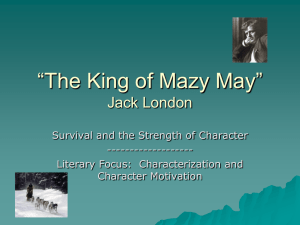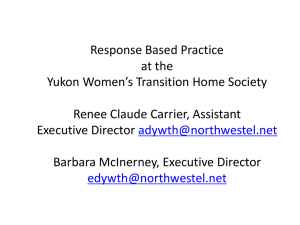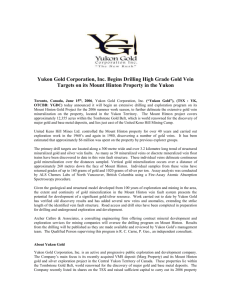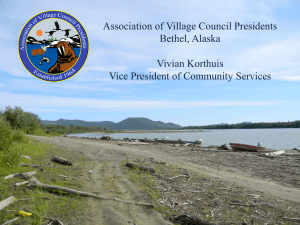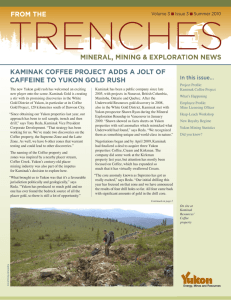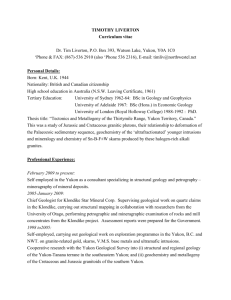Mining and Yukon First Nations
advertisement
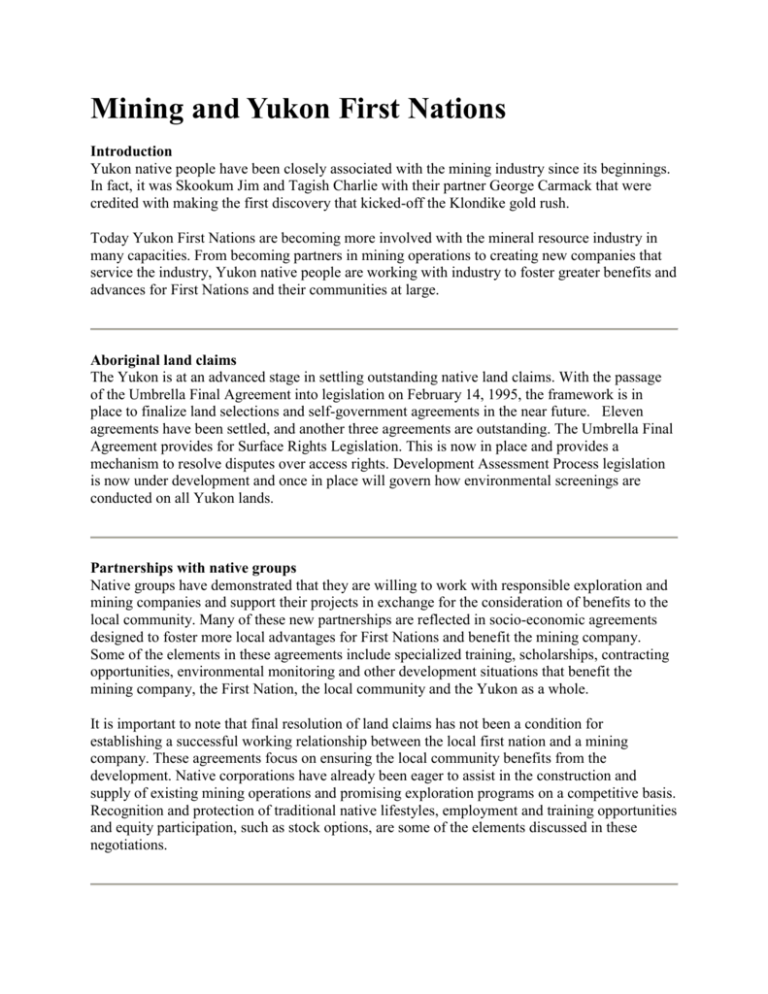
Mining and Yukon First Nations Introduction Yukon native people have been closely associated with the mining industry since its beginnings. In fact, it was Skookum Jim and Tagish Charlie with their partner George Carmack that were credited with making the first discovery that kicked-off the Klondike gold rush. Today Yukon First Nations are becoming more involved with the mineral resource industry in many capacities. From becoming partners in mining operations to creating new companies that service the industry, Yukon native people are working with industry to foster greater benefits and advances for First Nations and their communities at large. Aboriginal land claims The Yukon is at an advanced stage in settling outstanding native land claims. With the passage of the Umbrella Final Agreement into legislation on February 14, 1995, the framework is in place to finalize land selections and self-government agreements in the near future. Eleven agreements have been settled, and another three agreements are outstanding. The Umbrella Final Agreement provides for Surface Rights Legislation. This is now in place and provides a mechanism to resolve disputes over access rights. Development Assessment Process legislation is now under development and once in place will govern how environmental screenings are conducted on all Yukon lands. Partnerships with native groups Native groups have demonstrated that they are willing to work with responsible exploration and mining companies and support their projects in exchange for the consideration of benefits to the local community. Many of these new partnerships are reflected in socio-economic agreements designed to foster more local advantages for First Nations and benefit the mining company. Some of the elements in these agreements include specialized training, scholarships, contracting opportunities, environmental monitoring and other development situations that benefit the mining company, the First Nation, the local community and the Yukon as a whole. It is important to note that final resolution of land claims has not been a condition for establishing a successful working relationship between the local first nation and a mining company. These agreements focus on ensuring the local community benefits from the development. Native corporations have already been eager to assist in the construction and supply of existing mining operations and promising exploration programs on a competitive basis. Recognition and protection of traditional native lifestyles, employment and training opportunities and equity participation, such as stock options, are some of the elements discussed in these negotiations. Reasons why exploration companies and First Nations should work together The development of a strong working relationship between exploration companies and First Nations is important for many reasons. Understanding each other's concerns and needs is an important step towards good communication. Most exploration activities in Canada occur where traditional use of land continues. Aboriginal people make up a significant proportion of the work force in the northern part of Canada where, coincidentally, most of the mineralized areas of the country are found. The right of aboriginal people to self-government is being increasingly recognized. Provinces and territories are negotiating land claim agreements that may have an impact on mining exploration. The Yukon Environmental Assessment and Socio-economic Assessment Act (YESAA) encourages companies to consult with First Nations early in the planning and development stages of an environmental assessment application. First Nations, under the YESAA regime, are a decision bodies for any plans or projects that have the potential to adversely affect their settlement lands, and economic and social well being. Traditional Knowledge is quickly becoming recognized as a valuable tool in managing Yukon lands and waters. Companies that consult with First Nations early and effectively will create a more stable political and legal climate for the Yukon as a whole. A typical socio-economic agreement may include: Establishment of employment and training programs recruitment, training and development, and other employment provisions (including an employment opportunities committee, First Nation hiring policies, an Aboriginal Liaison Co-ordinator, work rotations, scholarship programs, counseling, youth awareness programs, cross-cultural training, and traditional economic activities) Provision of economic development and business opportunities business opportunities, and economic and business development committee, other economic and business provisions (including bid tenders and special allowances such as fragmentation of contracts and purchase packages) Development of social, cultural and community support programs a committee for community support and other community services such as communication and environmental protection Program implementation and evaluation management committee, liaison officer, agreement term, and agreement evaluation process Funding the company should provide the largest share of the funding to implement the agreement Legal issues Aboriginal, treaty and constitutional rights, and obligations to meet the terms of any collective agreement Key Consultation Components The following are some of the key consultation components that should be addressed by exploration companies as part of their basic research and work plan development: Identify nearby communities. Identify key contact people in nearby communities (e.g. chief, councilors, lands officer, administrators, mayor). Identify issues and concerns of importance to the communities. Communicate the company’s short and long term plans. Be aware of local cultural differences and communication styles. Initiate meetings to exchange information between the company president and the chief or other senior official(s). Settlement land categories As outlined in the Umbrella Final Agreement, Yukon First Nations will receive total settlement lands of approximately 41, 595 square kilometers or about 8.5 percent of the total land area of the Yukon. Category A settlement land - a Yukon First Nation has ownership of the surface and subsurface, including minerals. Category B settlement land - a Yukon First Nation has ownership of surface. Fee simple settlement land - a Yukon First Nation has the same fee simple title as other land registered in the Land Titles Office. First Nations Contact: Alan Carlick First Nation Liaison Officer Phone: 867.667.8708 Email: alan.carlick@gov.yk.ca See also: Council of Yukon First Nations Yukon Government Land Claims Secretariat


